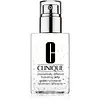Philosophy Hope In A Jar Water Cream Hyaluronic Glow Moisturizer Versus Clinique Dramatically Different Hydrating Jelly
What's inside
What's inside
 Key Ingredients
Key Ingredients

 Benefits
Benefits

 Concerns
Concerns

 Ingredients Side-by-side
Ingredients Side-by-side

Water
Skin ConditioningGlycerin
HumectantPentylene Glycol
Skin ConditioningCaprylic/Capric Triglyceride
MaskingPentaerythrityl Tetraethylhexanoate
EmollientCetearyl Alcohol
Emollient1,2-Hexanediol
Skin ConditioningCaprylyl Glycol
EmollientDimethicone
EmollientAmmonium Acryloyldimethyltaurate/Beheneth-25 Methacrylate Crosspolymer
Emulsion StabilisingButylene Glycol
HumectantCetearyl Glucoside
EmulsifyingMethylpropanediol
SolventSodium Polyacrylate Starch
AbsorbentParfum
MaskingAnanas Sativus Fruit Extract
Skin ConditioningLaureth-3
EmulsifyingCitric Acid
BufferingHydroxyethylcellulose
Emulsion StabilisingGlucosyl Hesperidin
HumectantGuar Hydroxypropyltrimonium Chloride
Skin ConditioningAcetyl Dipeptide-1 Cetyl Ester
Skin ConditioningLimonene
PerfumingHyaluronic Acid
HumectantSodium Benzoate
MaskingPotassium Sorbate
PreservativeSilanetriol
Hydrolyzed Opuntia Ficus-Indica Flower Extract
AbrasiveAgave Americana Leaf Extract
Skin ConditioningCI 42090
Cosmetic ColorantCI 17200
Cosmetic ColorantWater, Glycerin, Pentylene Glycol, Caprylic/Capric Triglyceride, Pentaerythrityl Tetraethylhexanoate, Cetearyl Alcohol, 1,2-Hexanediol, Caprylyl Glycol, Dimethicone, Ammonium Acryloyldimethyltaurate/Beheneth-25 Methacrylate Crosspolymer, Butylene Glycol, Cetearyl Glucoside, Methylpropanediol, Sodium Polyacrylate Starch, Parfum, Ananas Sativus Fruit Extract, Laureth-3, Citric Acid, Hydroxyethylcellulose, Glucosyl Hesperidin, Guar Hydroxypropyltrimonium Chloride, Acetyl Dipeptide-1 Cetyl Ester, Limonene, Hyaluronic Acid, Sodium Benzoate, Potassium Sorbate, Silanetriol, Hydrolyzed Opuntia Ficus-Indica Flower Extract, Agave Americana Leaf Extract, CI 42090, CI 17200
Water
Skin ConditioningBis-PEG-18 Methyl Ether Dimethyl Silane
EmollientButylene Glycol
HumectantGlycerin
HumectantCucumis Sativus Fruit Extract
EmollientHypnea Musciformis Extract
Skin ProtectingGelidiella Acerosa Extract
Skin ProtectingHordeum Vulgare Extract
EmollientPadina Pavonica Thallus Extract
Skin ConditioningHelianthus Annuus Seedcake
AbrasiveSucrose
HumectantCaffeine
Skin ConditioningSodium Hyaluronate
HumectantHydroxyethyl Urea
HumectantHydrolyzed Rice Extract
Skin ConditioningSorbitol
HumectantSodium Polyaspartate
HumectantPPG-6-Decyltetradeceth-30
EmulsifyingEthylhexylglycerin
Skin ConditioningPropylene Glycol Dicaprate
EmollientCaprylyl Glycol
EmollientTrehalose
HumectantPolysorbate 80
EmulsifyingCarbomer
Emulsion StabilisingSodium Hydroxide
BufferingHexylene Glycol
EmulsifyingCitric Acid
BufferingSodium Citrate
BufferingDisodium EDTA
Phenoxyethanol
PreservativeWater, Bis-PEG-18 Methyl Ether Dimethyl Silane, Butylene Glycol, Glycerin, Cucumis Sativus Fruit Extract, Hypnea Musciformis Extract, Gelidiella Acerosa Extract, Hordeum Vulgare Extract, Padina Pavonica Thallus Extract, Helianthus Annuus Seedcake, Sucrose, Caffeine, Sodium Hyaluronate, Hydroxyethyl Urea, Hydrolyzed Rice Extract, Sorbitol, Sodium Polyaspartate, PPG-6-Decyltetradeceth-30, Ethylhexylglycerin, Propylene Glycol Dicaprate, Caprylyl Glycol, Trehalose, Polysorbate 80, Carbomer, Sodium Hydroxide, Hexylene Glycol, Citric Acid, Sodium Citrate, Disodium EDTA, Phenoxyethanol
 Reviews
Reviews

Ingredients Explained
These ingredients are found in both products.
Ingredients higher up in an ingredient list are typically present in a larger amount.
Butylene Glycol (or BG) is used within cosmetic products for a few different reasons:
Overall, Butylene Glycol is a safe and well-rounded ingredient that works well with other ingredients.
Though this ingredient works well with most skin types, some people with sensitive skin may experience a reaction such as allergic rashes, closed comedones, or itchiness.
Learn more about Butylene GlycolCaprylyl Glycol is a humectant and emollient, meaning it attracts and preserves moisture.
It is a common ingredient in many products, especially those designed to hydrate skin. The primary benefits are retaining moisture, skin softening, and promoting a healthy skin barrier.
Though Caprylyl Glycol is an alcohol derived from fatty acids, it is not the kind that can dry out skin.
This ingredient is also used as a preservative to extend the life of products. It has slight antimicrobial properties.
Learn more about Caprylyl GlycolCitric Acid is an alpha hydroxy acid (AHA) naturally found in citrus fruits like oranges, lemons, and limes.
Like other AHAs, citric acid can exfoliate skin by breaking down the bonds that hold dead skin cells together. This helps reveal smoother and brighter skin underneath.
However, this exfoliating effect only happens at high concentrations (20%) which can be hard to find in cosmetic products.
Due to this, citric acid is usually included in small amounts as a pH adjuster. This helps keep products slightly more acidic and compatible with skin's natural pH.
In skincare formulas, citric acid can:
While it can provide some skin benefits, research shows lactic acid and glycolic acid are generally more effective and less irritating exfoliants.
Most citric acid used in skincare today is made by fermenting sugars (usually from molasses). This synthetic version is identical to the natural citrus form but easier to stabilize and use in formulations.
Read more about some other popular AHA's here:
Learn more about Citric AcidGlycerin is already naturally found in your skin. It helps moisturize and protect your skin.
A study from 2016 found glycerin to be more effective as a humectant than AHAs and hyaluronic acid.
As a humectant, it helps the skin stay hydrated by pulling moisture to your skin. The low molecular weight of glycerin allows it to pull moisture into the deeper layers of your skin.
Hydrated skin improves your skin barrier; Your skin barrier helps protect against irritants and bacteria.
Glycerin has also been found to have antimicrobial and antiviral properties. Due to these properties, glycerin is often used in wound and burn treatments.
In cosmetics, glycerin is usually derived from plants such as soybean or palm. However, it can also be sourced from animals, such as tallow or animal fat.
This ingredient is organic, colorless, odorless, and non-toxic.
Glycerin is the name for this ingredient in American English. British English uses Glycerol/Glycerine.
Learn more about GlycerinWater. It's the most common cosmetic ingredient of all. You'll usually see it at the top of ingredient lists, meaning that it makes up the largest part of the product.
So why is it so popular? Water most often acts as a solvent - this means that it helps dissolve other ingredients into the formulation.
You'll also recognize water as that liquid we all need to stay alive. If you see this, drink a glass of water. Stay hydrated!
Learn more about Water